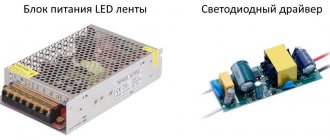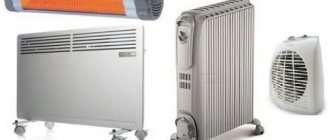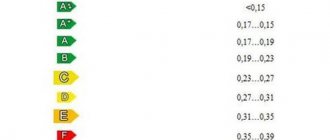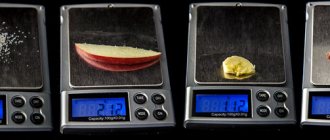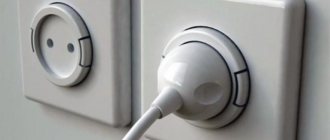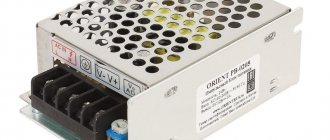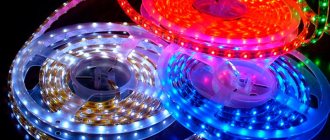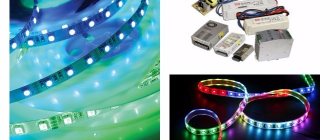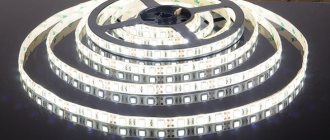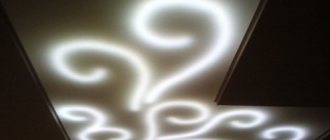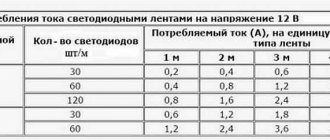LED strips are supplied to retail chains in reels of 5 meters (less often 2.5-10 m). There are wires at each end for connection. There are 2 technologies used in production - SMD and DIP. Self-installation requires calculation of the power of LED strips , electricity consumption, and parameters of voltage converters. Although the formulas are simple, a certain level of knowledge is required to obtain the correct result.
Types of LEDs
SMD diodes are mounted on a flexible tape using surface mount technology (soldered to the board). DIP packages are equipped with legs, so they are mounted on a flexible board before soldering. SMD strips are flat and emit light parallel to the mounting plane. DIP is a chain of cylinders that is used for tuning vehicles, for decorating large banquet halls, facades, outdoor advertising structures, squares, even trees.
To produce monochrome (single-color) LED strips, the same type of diodes are used. They can emit red, yellow, green, blue, white light, and less often orange or pink. Products with ultraviolet and infrared radiation are available for medical institutions, greenhouses, greenhouses. White light has different shades: yellowish, neutral, blue. When installing 3 crystals in one chip, it is called RGB .
The LED strip can be ordinary and waterproof (in a silicone shell) and is marked with the letters RTW.
The degree of protection is indicated by the letters IP and numbers:
- the first is safety for people and the level of protection from external mechanical influences;
- the second is the level of protection from high humidity;
- 0 – no protection.
When installed in heated rooms, protection is not of great importance. For wet rooms, a flexible LED strip with IP67 and IP68 is selected. For outdoor installation IP43 or more.
In a standard LED strip, the number of LEDs per 1 meter is 30 or 60. With a double increase in density, the product is designated as “x2”. If the LEDs are installed in 2 rows, they are marked “2x2” (120 or 240 chips per meter).
Attention! Some manufacturers offer flexible strips with LEDs installed in 3 and 4 rows. During installation, it is necessary to take into account that due to overheating, they must be placed on a rigid metal base.
LED strips with SMD are frontal, emit light at an angle of 120 degrees. Flexible strips with DIP are end-mounted; the light flux is scattered along the installation plane, so they are used indoors for decorative lighting.
What you should pay attention to
Number of LEDs on a strip
LEDs are most often sold in reels, each 5 meters long; the exact number of LEDs is recorded on the packaging.
When choosing a lighting device, you need to pay attention to the following parameters:
- installation methods;
- type of installed LED bulbs (the level of illumination will depend on this parameter);
- degree of protection;
- power consumption (the parameters of the purchased power supply will depend on this indicator);
- supply voltage;
- number of LEDs;
- color.
Build quality
LED strip Osram Smart+ Apple HomeKit Flex, 10 W
The build quality and materials used in manufacturing directly depend on the manufacturer. The most popular products on the market are Arlight, Gauss, Cree, Feron, Navigator and OSRAM.
It is recommended to purchase lighting devices in places where they provide a guarantee, and you also have the opportunity to check the functionality of the device and hold it in your hands.
The following defects are most often encountered in the manufacture of LED light bulbs:
- soldering of a product made from several separate pieces;
- poor quality soldering;
- flashing or poorly functioning segments.
If the buyer decides to make a purchase through an online store, he first needs to study reviews about the seller.
Degree of protection
The degree of protection is usually fixed in accordance with international standards. This parameter must be indicated on the packaging. If there is no information, you should doubt the quality of the product offered.
Open LED strips are marked IP20. They are designed to work in dry rooms where moisture protection is not required. Most often it is used to illuminate ceilings and cabinet furniture.
IP65 marking – products characterized by partial protection from moisture. Used for installation in bathrooms, provided that there is no possibility of water getting on them.
The degree of protection IP68 indicates complete protection of the tape from moisture. The device can be used in a humid environment at a depth of up to 1 meter. However, in this case, for safety reasons, it is recommended to additionally use residual current devices.
Supply voltage and power
The chemical composition of the semiconductor largely determines the supply voltage of the LEDs.
A specific model has its own supply voltage; these data must also be indicated by the manufacturer on the packaging. There are the following types of denominations:
- +5V – applicable for lighting devices powered from USB connectors on computers. Recently, it has often been used to decorate wardrobe elements. The peculiarity of the work is to convert energy from 1.5V batteries into 5V direct current.
- +12V is the most common type of rating intended for powering tapes. For uninterrupted and productive operation, special power supplies - drivers are used.
- +24V – used if there is a need for backup power in the event of a power failure. The battery will work much longer, provided that the current for segments of equal power is half as much. There is another reason to use this rating - in case of large distances between the tape and power sources. Thanks to this, it is possible to reduce the voltage drop caused by the resistance of the electrical wiring.
- +36V – rarely used, since manufacturers rarely produce power supplies with this rating. If the device fails, it is unlikely that it will be possible to quickly find a replacement. The advantage of use is the reduced current that the lighting device will consume.
You can also find out the power of an LED strip by the type of LED bulbs used.
LEDs of the same power, but different colors will have different luminous flux. General parameters must be indicated in the tables of the accompanying documentation. The fullness of the luminous flux depends on the power of each LED bulb.
Number of colors and color shade
In addition to the main colors, you can find examples of crimson, turquoise or purple glow.
Manufacturers of LED strips produce products in the following colors:
- RGB, multicolor;
- cold white;
- yellow;
- blue;
- red;
- green;
- warm white.
The color pink is gaining popularity. Its demand is largely due to its great benefits for the growth and development of plants.
Voltage and current
All types of LED strips are connected to the network through a power source that stabilizes voltage and current. Standard products are designed to operate from 12 volts , but there are flexible LED strips for 5 (with built-in PWM controller), 24 and 36 volts. Good manufacturers mark the value of this parameter on the tape.
The amount of current depends entirely on what LEDs are installed and how many there are on the meter and the entire strip.
Important! When purchasing a piece (without a reel), you need to ask the seller for the voltage and current values.
How much does an LED strip consume depending on the type of LED?
LEDs have firmly entered our lives; they are used in various fields from construction to the space industry. Not only LED light bulbs are in demand, but also LED strips. It would be interesting to know how much an LED strip consumes. Typically, LED strips (strips) are used to decorate the interior; they add coziness to the room and allow you to create stunningly beautiful lighting effects at home. In addition, this product allows you to effectively and beautifully highlight beneficial elements of decor and interior design. What is an LED strip (strip)? This is a special device with a flexible base on which LEDs are located in series. LED strips are low-voltage equipment, which makes it difficult to connect these devices to a general 220 Volt network. For this reason, special power supplies, so-called voltage converters, are used to connect these products. If the blocks are not used to connect the strip directly, it will burn out. Typically, the product operates in two low-voltage versions: 12 and 24 Volts, however, there are also options with 18 Volt units. Let's figure out how economical the energy consumption of these devices is.
Power determination
On the packaging, the power of one meter or the entire product is indicated in watts. When choosing a power supply, the main attention should be paid to this indicator.
Attention! Recently they began to produce LED strips with a voltage of 220 V, for which a converter is not required, since they are connected directly to the network.
Calculation of the power of 1 meter of LED strip
The power value of 1 m of LED strip depends on the type of LEDs that are placed on it and their number. If there is no passport or the value is not indicated (not all manufacturers have a high level of responsibility), you need to measure the meter with a tape measure, determine the length and width of the chips and count how many of them are installed.
Based on the dimensions, you can determine the type of SMD and find a table with current values (in amperes ):
- SMD 3528 – 0.02;
- SMD 5050 – 0.02;
- SMD 5630 – 0.15-0.2;
- SMD 5730 – 0.15-0.3;
- SMD 2835 – 0.06;
- SMD 3014 – 0.03;
- SMD 3020 – 0.02.
Power formula:
P = U*I*N/K, where:
U – power supply voltage;
I – current;
N – number of chips per meter;
K – number of SMDs connected in series.
All 12V LED strips have 3 chips in groups connected in parallel, so K=3 (for 24V K=6).
Example:
The size of the SMD 3020 chip is 30x20 mm, 30 elements per meter, 12 V power supply.
P = 12*0.02*30/3 = 2.4 W.
If there are 60 chips:
P – 24*0.02*60/3 = 9.6 W.
What power should I choose for lighting a room?
We promised to tell you how to find out how much light is needed for the necessary and high-quality lighting in a room. Knowing the power of the LED strip, it is not difficult to determine how much light we will get from it. In the characteristics table, a parameter such as luminous flux is indicated. What does this mean?
Theory
Luminous flux is a quantity that indicates how much light the emitted flux emits. It is measured in lumens (abbreviated Lm).
Illumination is measured in lux (abbreviation according to SI - lux) - it shows the ratio of the value of the drop in luminous flux from one meter of height to one square meter of area.
Illumination depends on how far away the light source is. The farther the lamp is, the weaker it shines. In physics, this phenomenon is explained by the inverse square law.
Demonstration of the dispersion of the concentration of light flux depending on the distance where it hits.
The inverse square law states that the value of a certain physical quantity at a specific point in space is inversely proportional to the square of the distance from the source that this quantity characterizes.
Converter calculation
When purchasing a unit for an existing LED strip, not only power is taken into account, voltage is equally important.
Attention! 12 V converters are more accessible and have a relatively low cost; if they fail, they are easier to replace.
To determine the power of the block, the power of the tape must be multiplied by 0.2 or 0.3. For the LEDs discussed above, with length of 15 m and 60 chips on each of them, its power is:
9.6*15 = 144 W.
Taking into account the coefficient:
144+144*0.3 = 187.2 W
The power supply power should be 200 W.
Attention! If you do not take into account the reserve, the unit will not be able to produce a stable voltage at the output and will overheat.
If the block seems too large, the LED strip can be divided into 2 parts, for each buy a 100- watt .
How to determine the required parameter for one diode
If it is not possible to use reference books to find out how much current one LED consumes, then you can take measurements yourself. This must be done in a situation where the length of the backlight will not be integral (for example, 2.4 m).
Note! LEDs can shine in different colors (white, red, blue and green). And each type will consume a certain amount of current. For example, a red diode almost always uses 20 mA.
LEDs
To determine the required value you will need:
- laboratory power supply, rated for 12 volts;
- fixed resistors (1 kOhm, 560 Ohm and 2.2 kOhm);
- milliammeter;
- digital voltmeter;
- installation wire;
- powerful variable resistor 470-680 Ohm.
You need to define it as follows:
- We find out the polarity of the diode using a mounting wire and a constant resistor. If the diode lights up, it will be “+”;
- We assemble an electrical circuit: a constant resistor for the desired diode, a variable resistor, and a milliammeter. A voltmeter must be connected in parallel to the LED;
Voltmeter
- set the variable resistor to maximum resistance;
- connect the circuit;
- record the instrument readings;
- Next, we reduce the resistance for the variable resistor and look at the voltmeter. Readings should be recorded every 0.1V with increasing voltage;
- when the voltage increases less than the current, we reduce the resistance of the resistor.
As a result, we get the current of one diode.
Consumption calculation
Before installing a lighting system, anyone wants to know its energy consumption .
The amount consumed by an LED strip primarily depends on the number of diodes. If you use the product discussed above, then we can say that electricity consumption is the power of the power supply. To determine the exact value, you need to know how many hours daily the lighting system will be used.
If it works approximately 3 hours a day, the calculation is as follows:
200 W*3/1000 = 6 kW/day.
12 V LED strip: advantages and disadvantages
Among the disadvantages of the LED strip, only two can be noted - high cost and strip length, which is a maximum of 5 m, which is associated with the need for uniform illumination over the entire area. However, these disadvantages are gradually becoming a thing of the past - the cost is decreasing, and the maximum length... Today, coils of 200 m are available for sale, which means that the second disadvantage disappears.
Light strips in 200 m bays appeared relatively recently
This lighting element has many advantages:
- compactness;
- ease of installation;
- flexibility;
- low supply voltage and low power consumption;
- safety during operation.
The list can be continued for a long time. In any case, it is clear that 12 V LED strips are an excellent solution for household lighting.
Not only aesthetics, but also safety. Step lighting is quite a necessary thing
Main conclusions
The large volume of LED products offered on the market is not of high quality. Manufacturers do not indicate the parameters of voltage, current, power, or offer connection diagrams. The chips are made from low quality crystals and phosphors. When purchasing such products, to determine the current-voltage characteristics; calculations based on measurements are required.
If the tape is of high quality, it will serve the stated period only when connected through a power supply selected based on accurate calculations. Another condition is compliance with the operating regime.
When purchasing products from CREE, Philips, OSRAM, the system will work for the stated 30-50 thousand hours, if you take a responsible approach to the selection of additional components and installation. Calculations of power and energy consumption will not create problems, since these manufacturers indicate all the necessary parameters on their products.
Do I need a driver or is a regular power supply sufficient?
To answer this question, you need to understand what a driver is and what its functions are. It is known that the parameter that sets the operating mode of LEDs is current. If it is lower than nominal, the LED will shine less brightly. If the current is higher than that set by the manufacturer, the LED emits brighter light, but its lifespan is reduced. At a certain value, the semiconductor device instantly fails.
In this case, the driver means a power supply that performs two functions:
- current limitation via LED;
- maintaining this current at a set level regardless of the input voltage parameters (current stabilization).
The second function also solves the issue of compensating for input voltage surges, which also significantly reduce the life of light-emitting diodes.
Electrical circuit diagram of LED strip.
When studying the LED strip circuit, it becomes clear that it consists of parallel-connected cells made of a series-connected resistor and LED. The resistor limits the current, but cannot stabilize it - the brightness will change synchronously with the change in the input voltage. If this voltage is stabilized, then, according to Ohm's law, the current will also be stable (with a constant resistance). Hence the conclusion - if you choose a power source with voltage stabilization, a driver is not needed.
Precautions when using high-power LEDs
The greater the power of the LED, the more carefully you need to approach the installation and operation of the product. By following a few rules, you will protect yourself from trouble.
Firstly, the tape should not be damaged. Secondly, consider the electrical polarity when connecting the products. Third, beware of unbalanced voltage drops, which can damage the LEDs. Fourthly, connect the pieces of tape only in parallel. Connecting high-power LEDs in series can cause them to burn out.
Start shopping
Section: Plain
The nuances of connecting a light strip to the vehicle’s on-board network
Many people think that if the required voltage for an LED strip is 12 Volts, it will be ideal for a car, even with a direct connection, however, this is a strong misconception. The voltage of the car's on-board network floats in the range of 12-14.5 V, which means that by connecting the strip directly, we will get a backlight that will not work for more than a week. There are several solutions here.
The most common is to install a limiting resistor on the positive input. However, with this switching on, the intensity of the diodes will “float” while the engine is running. If uniform illumination is a priority for the motorist, you can use another method.
Connecting the light strip to the vehicle's on-board network
It is necessary to purchase a linear voltage stabilizer (LSN). Essentially, it is an integrated circuit (IC). The best choice would be LM7812, but only on condition that the voltage in the on-board network does not fall below 14 V. Otherwise, the light diodes will flicker noticeably. If this is observed, then it is better to install LM317, designed for a voltage of 12.3 V, as an LSN.
